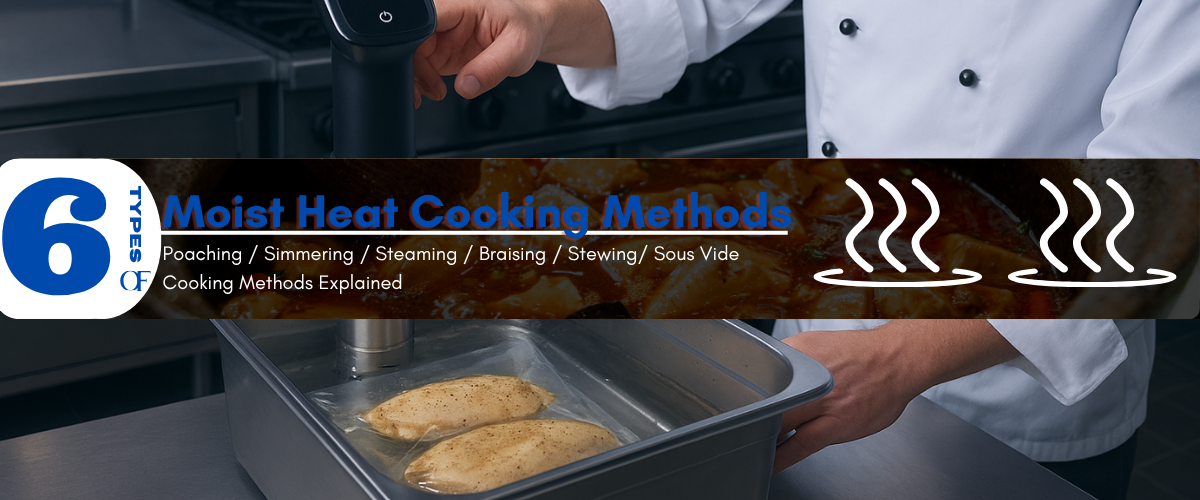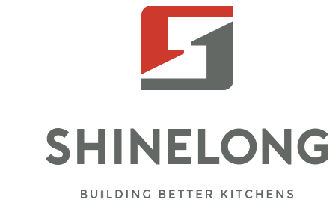News
6 Types of Moist Heat Cooking Methods | Cooking Methods Explained

The culinary world is rich with cooking methods, but most techniques fundamentally fall into two main categories: dry heat and moist heat cooking. In this guide, we'll walk you through six common types of moist heat cooking methods, which are highly relevant to both the home cook and any hospitality foodservice.
What Is Moist Heat Cooking?
Moist cooking relies on water or any hot liquid to transfer heat to food, which is way more different than dry heat cooking. Moist heat cooking is the go-to method for tenderizing ingredients like a tough shoulder of beef or a whole chicken, and it also helps retain the original flavors and nutrients. This technique is especially popular in East Asia (such as China) and the Mediterranean.
This technique generally involves cooking food in a bubbling hot liquid, typically within a temperature range of 85℃ to 100℃; however, different methods have their own specific temperature requirements. Now, we'll detail the six major methods, from poaching to stewing, so you can master them on your culinary journey!

Poaching
Poaching is the most delicate form of moist heat cooking, a method that treats food with patience and precision. The liquid never boils; it quietly shimmers around 70 to 80°C, just enough to set proteins gently without breaking their structure. In star hotels and fine dining, poaching is the secret behind perfectly tender chicken breasts, poached salmon fillets, or classic breakfast eggs that glide like silk on the plate.
Chefs often use tilting skillets or wide poaching pans that allow water to circulate evenly around each portion. When done right, poaching enhances natural flavors, preserves color, and locks in moisture. It’s a technique that values control over speed, ideal for menus where refinement and consistency matter most.
Simmering
Simmering is the quiet engine of every professional kitchen, a slow and steady method that builds flavor over time. Liquids hover between 85 and 96°C, bubbling softly as ingredients surrender their essence to the broth. From clear consommés to rich curries or vegetable soups, simmering forms the foundation of endless hotel dishes served at buffets or banquets.
Large-volume operations rely on steam-jacketed kettles or heavy stockpots to hold a constant temperature. The gentle motion of the liquid keeps sauces smooth and flavors balanced, avoiding the harsh agitation that can cloud stocks or overcook ingredients. A good simmer is like a conversation; it takes time, but it rewards you with depth and warmth.
Steaming
Steaming is the cleanest and most efficient way to cook in a high-output commercial kitchen. Instead of immersing food in water, chefs let steam surround it completely, preserving nutrients, texture, and bright natural color. The technique is essential in Asian-style banquet operations, wellness restaurants, and large hotels where consistency and health standards are equally important.
Professional kitchens depend on combi ovens and stainless steel steaming cabinets to manage dozens of trays at once. Vegetables remain vibrant, seafood stays juicy, and dumplings come out glossy and tender. Because steam transfers heat evenly, it’s an ideal solution for operations where speed, hygiene, and batch quality must coexist.
Braising
Braising combines two worlds—dry and moist heat—to turn tough cuts into dishes of extraordinary tenderness. Food is first seared in oil to build flavor, then simmered slowly in liquid until fibers soften completely. The temperature sits around 95°C, long enough for the collagen to melt but gentle enough to protect the meat’s texture.
Hotels and large restaurants favor tilt skillets and braising pans for this method, since they allow searing, deglazing, and stewing in one unit. Braised beef short ribs, lamb shanks, and oxtail stew are banquet favorites because they can be prepared in advance and reheated without losing moisture. Braising celebrates transformation—the humble cut reborn as a luxurious meal.
Stewing
Stewing is the heart of comfort food in catering kitchens. Ingredients are cut small, submerged in liquid, and cooked slowly until they merge into one rich, aromatic dish. Temperatures stay steady, close to 90°C, allowing time for vegetables, grains, and proteins to blend their flavors into harmony.
Chefs turn to deep stockpots or tilting kettles when preparing large batches of chicken stew, lentil curry, or seafood gumbo. Stewing offers flexibility for high-volume production—it’s easy to portion, holds heat well, and tastes even better when reheated. For hotels serving hundreds daily, it’s a reliable, flavor-deepening method that never disappoints.
Sous Vide
Sous vide represents the precision era of moist heat cooking. Food is vacuum-sealed and submerged in a water bath that maintains a perfectly stable temperature, often between 55 and 80°C, depending on the ingredient. This control allows chefs to achieve results impossible by traditional means—chicken breasts that stay juicy, steaks that cook evenly edge to edge, or vegetables that retain their natural sweetness.
Modern hospitality kitchens rely on sous vide machines and stainless steel holding tanks to prepare hundreds of servings with identical quality. The process minimizes waste, saves time, and ensures every dish meets exact doneness standards. For restaurants focused on fine dining and consistency, sous vide is not just innovation; it’s discipline perfected through water and patience.
How to Choose the Right Moist Heat Technique
Choosing the correct method comes down to three questions: what is the ingredient, what is the desired texture, and how large is the batch? In catering or banquet scenarios, consider methods that scale with minimal hands-on time; braising, stewing, and sous vide often excel here. For fine dining, poaching and sous vide provide delicate control and visual appeal.
Also, industrial kitchen equipment availability: a hotel with combi ovens and tilting frying pans can pivot between steaming, braising, and simmering with ease. Smaller operations might rely on commercial electric ranges and stockpots, choosing methods that match both menu and unit.
FAQs
Q1: What’s the main difference between simmering and poaching?
Poaching uses a lower temperature for delicate proteins, while simmering cooks tougher ingredients longer for deeper flavor development.
Q2: Is sous vide considered moist heat cooking?
Yes, sous vide is a precise form of moist heat cooking since it uses water to transfer heat to vacuum-sealed food.
Q3: Which commercial kitchen equipment is most versatile for moist heat methods?
The tilt skillet and combi oven are top choices—they handle poaching, braising, and even steaming with consistent results.
Q4: How does moist heat cooking impact menu quality?
It enhances tenderness and preserves natural juices, giving customers that “just-right” bite every time.
Q5: What’s the best method for batch cooking in hotels or catering?
Stewing and braising are the most reliable for high-volume prep. They reduce active monitoring while ensuring premium texture.
 After-Sales:
After-Sales:
 EN
EN
 AR
AR
 HR
HR
 NL
NL
 FI
FI
 FR
FR
 DE
DE
 EL
EL
 HI
HI
 IT
IT
 PT
PT
 RO
RO
 RU
RU
 ES
ES
 TL
TL
 ID
ID
 SL
SL
 VI
VI
 ET
ET
 MT
MT
 TH
TH
 FA
FA
 AF
AF
 MS
MS
 IS
IS
 MK
MK
 HY
HY
 AZ
AZ
 KA
KA
 UR
UR
 BN
BN
 BS
BS
 KM
KM
 LO
LO
 LA
LA
 MN
MN
 NE
NE
 MY
MY
 UZ
UZ
 KU
KU









